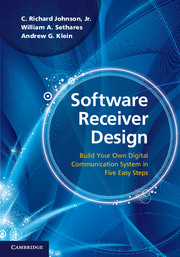Book contents
- Frontmatter
- To the Instructor …
- Contents
- Dedication
- Step 1 The Big Picture
- Step 2 The Basic Components
- Step 3 The Idealized System
- 4 Modeling Corruption
- 5 Analog (De)modulation
- 6 Sampling with Automatic Gain Control
- 7 Digital Filtering and the DFT
- 8 Bits to Symbols to Signals
- 9 Stuff Happens
- Step 4 The Adaptive Components
- Step 5 Putting It All Together
- Appendices
- Index
- References
5 - Analog (De)modulation
from Step 3 - The Idealized System
Published online by Cambridge University Press: 05 June 2012
- Frontmatter
- To the Instructor …
- Contents
- Dedication
- Step 1 The Big Picture
- Step 2 The Basic Components
- Step 3 The Idealized System
- 4 Modeling Corruption
- 5 Analog (De)modulation
- 6 Sampling with Automatic Gain Control
- 7 Digital Filtering and the DFT
- 8 Bits to Symbols to Signals
- 9 Stuff Happens
- Step 4 The Adaptive Components
- Step 5 Putting It All Together
- Appendices
- Index
- References
Summary
Several parts of a communication system modulate the signal and change the underlying frequency band in which the signal lies. These frequency changes must be reversible; after processing, the receiver must be able to reconstruct (a close approximation to) the transmitted signal.
The input message w(kT) in Figure 5.1 is a discrete-time sequence drawn from a finite alphabet. The ultimate output m(kT) produced by the decision device (or quantizer) is also discrete-time and is drawn from the same alphabet. If all goes well and the message is transmitted, received, and decoded successfully, then the output should be the same as the input, although there may be some delay δ between the time of transmission and the time when the output is available. Though the system is digital in terms of the message communicated and the performance assessment, the middle of the system is inherently analog from the (pulse-shaping) filter of the transmitter to the sampler at the receiver.
At the transmitter in Figure 5.1, the digital message has already been turned into an analog signal by the pulse shaping (which was discussed briefly in Section 2.10 and is considered in detail in Chapter 11). For efficient transmission, the analog version of the message must be shifted in frequency, and this process of changing frequencies is called modulation or upconversion. At the receiver, the frequency must be shifted back down, and this is called demodulation or downconversion.
- Type
- Chapter
- Information
- Software Receiver DesignBuild your Own Digital Communication System in Five Easy Steps, pp. 80 - 97Publisher: Cambridge University PressPrint publication year: 2011



